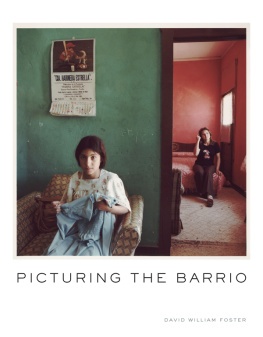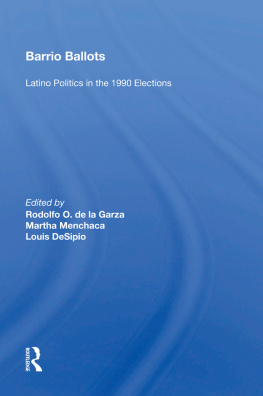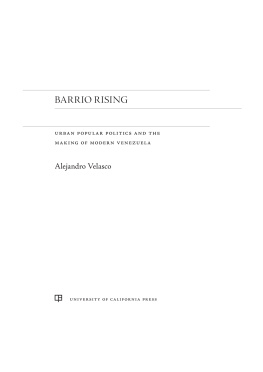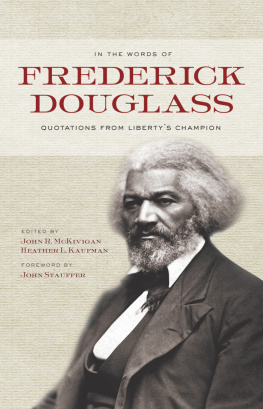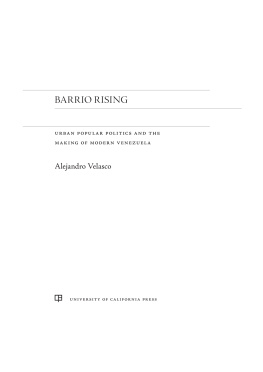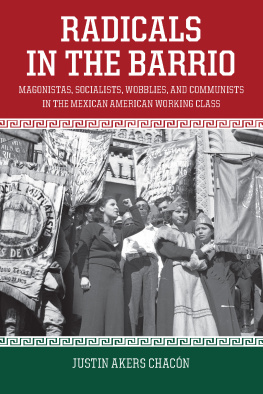FREDERICK F. WHERRY is associate professor of sociology at the University of Michigan. He is the author of Global Markets and Local Crafts: Thailand and Costa Rica Compared.
The University of Chicago Press, Chicago 60637
The University of Chicago Press, Ltd., London
2011 by The University of Chicago
All rights reserved. Published 2011.
Printed in the United States of America
20 19 18 17 16 15 14 13 12 11 1 2 3 4 5
ISBN-13: 978-0-226-89431-7 (cloth)
ISBN-10: 0-226-89431-2 (cloth)
ISBN-13: 978-0-226-89432-4 (paper)
ISBN-10: 0-226-89432-0 (paper)
ISBN-13: 978-0-226-89446-1 (e-book)
Library of Congress Cataloging-in-Publication Data
Wherry, Frederick F.
The Philadelphia barrio: the arts, branding, and neighborhood transformation / Frederick F. Wherry; with photographs by Tony Rocco.
p. cm.
Includes bibliographical references and index.
ISBN-13: 978-0-226-89431-7 (cloth: alk. paper)
ISBN-10: 0-226-89431-2 (cloth: alk. paper)
ISBN-13: 978-0-226-89432-4 (pbk.: alk. paper)
ISBN-10: 0-226-89432-0 (pbk.: alk. paper)
1. Hispanic American neighborhoodsPennsylvaniaPhiladelphia. 2. Community developmentPennsylvaniaPhiladelphia. 3. Community arts projectsPennsylvaniaPhiladelphia. I. Rocco, Tony. II. Title.
HT177.P4W54 2011
307.7609748'11dc22
2010049106

This paper meets the requirements of ANSI/NISO Z39.48-1992 (Permanence of Paper).
The Arts, Branding, and Neighborhood Transformation
The Philadelphia Barrio
FREDERICK F. WHERRY
with photographs by Tony Rocco
The University of Chicago Press
Chicago and London
For Charlie and Peggy, my parents
And to the memory of William Bryant Wellons III
Behold, I will do a new thing; now it shall spring forth; shall ye not know it? I will even make a way in the wilderness, and rivers in the desert.
ISAIAH 43:19
Contents
Preface
Now that the book is written, I can say that I know a little about how neighborhoods change and even more about the role of the arts in shaping and transforming their character. When I started doing the research for this book, I read the work of other social scientists whose analyses were at odds with what was happening in the Philadelphia barrio. Much of what I read was cynical: No good could come from capitalism, so attempts to use the arts and tourism to promote economic development could only result in the exploitation of the neighborhood, sowing the seeds of the communitys demise. As some scholars tell it, the arts become an instrument for making the neighborhood more attractive so that richer people would inhabit it. Once the members of the community succeed in making their neighborhood a better place, they are forced to move elsewhere. The services already rendered, the servicers are sent packing.
The cynics hold this perspective on neighborhood change because they have witnessed it firsthand. When newspaper reporters, real estate agents, and city officials talk about neighborhoods turning around, they are usually referring to a bounded territory rather than the people who live there. And they are almost never talking about the actual performances that initiate, maintain, and contest the type of transformation the neighborhood experiences. Even the demographic indicators of change are misleading. Poverty levels may drop considerably because most of the poor have moved. The crime rate may decline because the criminals (as well as anyone too near the scene of an alleged misdeed) have been incarcerated. New property owners (along with some old-timers who now have a fresh set of allies) find themselves needing to teach the longtime residents that cars in the midst of repair on public streets are unsightly and that trash on the sidewalks is unacceptable. Murals begin to replace graffiti as the public art of choice, with images of a conga drum braced between a mans thighs, a local poet singing as he plucks his guitar, a clump of dancers poised for performance with small red bows dotting their white dresses, and a tamed jungle sheltering a lion, a waterfall, a blue parrot.
With these murals forming the backdrop to locally owned stores selling items from Puerto Rico, Latin America, and the Caribbean, the whole area might easily be seen as a stage and its artists, business owners, and residents as merely players. But such a depiction belies what the performers do and why. Some of the graffiti artists write regardless of the presence of tourists. Many of the dancers perform to satisfy their own desires to participate in local festivals or to develop and show off their talents.
I witnessed how musical jam sessions provide opportunities for friends and acquaintances to shake off worry while stepping, twisting, and twirling in the streets. I came to understand how art events attract different people, institutions, and resources into the community, and how these resources and the resulting visibility can be used for other development purposes. I overheard parents talking with their children about feeling beautiful and proud. Business owners explained why they established their enterprises in this neighborhood and why some of them have stayed even though they had opportunities to move their businesses elsewhere. It dawned on me that the experience of business owners and residents in a neighborhood drenched with the arts probably differs from the experience of people in neighborhoods with similar poverty levels where the arts do not thrive. But their neighborhood does not look like other places that have turned around. Progress and transformation mean revival and redemptionthe return of life, the cleansing and nurturing of a new spirit.
This book focuses on how people within the Philadelphia barrio are defining and bringing about this transformation. Rather than presenting a caricature of individuals in stock roles that the reader can easily pin down, this book shows community leaders, artists, and business owners engaged in constant negotiations over what they should be doing and why. How should the community be represented in public parades, and how should the various Latino cultures be represented to different audiences? Which narratives are stigmatizing and which ones uplifting? How can local organizations sell the ethnic and cultural authenticity of their artists without selling outdistorting whats real for the sake of what consumers and funders seem willing to pay for? How do the neighborhoods history and prevailing urban myths influence the types of narratives told about the neighborhoods characteristics and the repertoire of symbols that marketers can use to promote those characteristics? These questions highlight how culturesymbols, myths, and ways of perceiving and talking about the worldand emotions are implicated in attempts to improve neighborhoods and the business districts anchoring them.
All over the country, community development corporations and city officials have touted tourism and the arts as pathways to urban revitalization. In San Francisco, for example, tourists have long flocked to the citys ethnic and gay neighborhoods, but the rough Tenderloin District was not high on the list of attractions. Now, even the Tenderloin is a candidate for transformation. Just as culture has become hot, so too has grittiness. The Tenderloins single-room occupancy hotels house the nearly homeless, and the local police have asked for special powers to combat the illegal drug trade thriving there. These facts may contribute to rather than detract from the Tenderloins allure. And when reality gets mixed with history and myth, the resulting combination sells, especially when the neighborhood can be safely experienced with only a hint of peril. Can this strategy lead to positive development outcomes for the people of the Tenderloin? How might the story of the Philadelphia barrio help us understand the promises and pitfalls of such strategies in different city and community contexts?

 This paper meets the requirements of ANSI/NISO Z39.48-1992 (Permanence of Paper).
This paper meets the requirements of ANSI/NISO Z39.48-1992 (Permanence of Paper).
